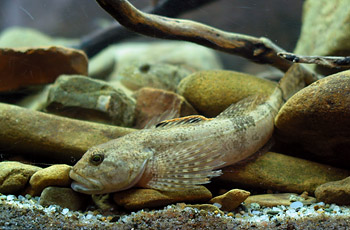Nature » Animated nature » Fauna
Fauna
Pisces
During the research, which covered the 3 largest watercourses – Wisloka, Ryjak, Wilsznia and 5 smaller streams, 12 species of pisces were found. Brook Minnow Phoxinus phoxinus is considered predominante in terms of its number – over 57% of the fish caught alive, the next are Chub Leuciscus cephalus and Spotted Barbel Barbus petenyi – slightly above 10%.

Alpine Bullhead (MNP arch.)
River Trout Salmo trutta m. fario makes about 7% of the whole amount of caught fish. Considering the biomass the predominantes are: Chub – over 43%, River Trout – 20% and Brook Minnow – 10% of the whole biomass.
The species composition of the pisces being found in the waters of the Magura National Park depends on the size of the watercourse. In the smallest, second-rate streams only 4 species can be found. Brook Minnow dominates there, Alpine Bullhead Cottus peocilopus is also quite numerous. The other two species are: River Trout and Stone Loach Neomacheilus barbatulus. The ichthyofauna of the third-rate streams is richer in only two more species and Brook Minnow also dominates there. In the fourth-rate watercourses there are 11 species, quite numerous are, apart from Brook Minnow, Spotted Barbel and Chub, other species are Stone Loach and River Trout. The only fifth-rate watercourse is Wisloka river downstream from the mouth of the Wilsznia river. There are also 11 species, yet neither of them dominates as visibly as Brook Minnow in the smaller streams. The most numerous is Spotted Barbel, the next are Brook Minnow, Cub, Stone Loach, European Chub (Schneider) Alburnoides bipunctatus and River Trout. Other species can be found in very little amount.
There are 4 protected species of ichthyofauna in the area of the MNP: Brook Minnow, Stone Loach, Alpine Bullhead and European Chub. The last one is very interesting as it is an extremely endangered species in Poland.


